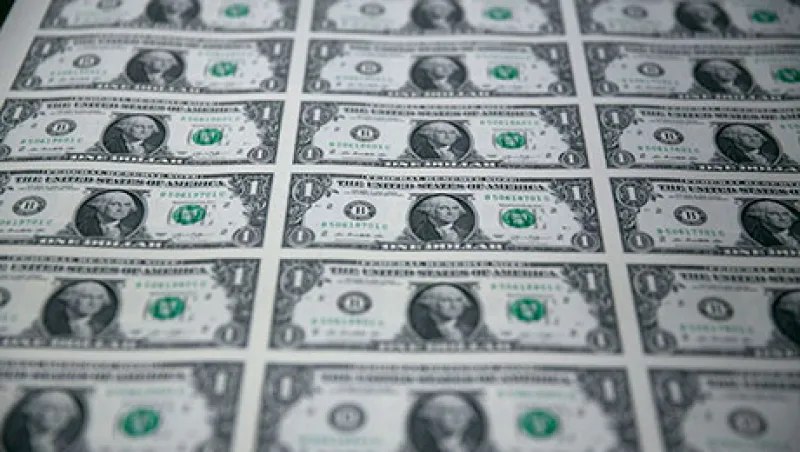Not everyone has shied away from U.S. Treasuries as yields have rebounded over the past two months.
Foreign central banks’ Treasury holdings rose for nine of the past ten weeks and matched a prior record high of $3.03 trillion on July 1, according to Federal Reserve data. The dollar’s decline from its 12-year peak in March and the rise in Treasury yields sparked the purchases. Central banks’ Treasury purchases often move inversely with the dollar.
“Milton Friedman called central banks ‘speculators,’” says Marc Chandler, global head of currency strategy for Brown Brothers Harriman in New York. “When the dollar stopped rising, they wanted to rebuild [dollar] reserves and prevent their currencies from rising too much.”
The U.S. dollar index, a measure of the greenback’s value against other major currencies, has dropped 4 percent since March 13. China, Russia, South Korea and Turkey have been active in rebuilding their dollar reserves (the Fed does not keep individual country data on Treasury holdings). When central banks increase their dollar reserves, they tend to invest those dollars in Treasuries.
As the ten-year Treasury yield rose to an eight-month high of 2.49 percent on June 10, central banks had an opportunity to buy Treasuries on the cheap. “With U.S. interest rates backing up, Treasuries are more attractive to the central banks,” says David Gilmore, a partner at currency research firm Foreign Exchange Analytics in Westbrook, Connecticut. Given paltry European yields, this trend is even more pronounced. The ten-year German Bund yields 0.76 percent, compared with 2.29 percent for the ten-year Treasury.
Emerging markets account for the lion’s share of foreign central bank Treasury purchases. And, says Gilmore, emerging markets are likely beefing up reserves of U.S. dollars in anticipation of Fed rate normalization. Fed chair Janet Yellen has indicated the central bank will probably begin boosting rates later this year, and many economists expect the first move to come in September.
If their currencies did plunge after the Fed acted — as happened during the so-called taper tantrum of mid-2013 — emerging-market central banks would likely sell Treasuries to raise dollars, which they would then sell to protect their currencies and stanch capital outflows, Gilmore says. But he sees that as an unlikely scenario.
To be sure, market participants don’t expect foreign central banks’ Treasury buying binge to continue much longer. “It’s dangerous looking at short-term movements that are opportunistic changes as a long-term trend,” says Robert Sinche, global strategist for securities firm Amherst Pierpont in New York. Given the recent weakness of their currencies, emerging-markets central banks aren’t in a position to buy lots of dollars, he notes.
The strong growth and tight monetary policy in the U.S. are likely to boost the greenback, discouraging foreign central banks from purchasing more Treasuries. Since June 18, the euro already has slid 2.6 percent amid Greece’s turmoil, and the ten-year Treasury yield dropped 10 basis points, to 2.29 percent, on Monday after Greece’s referendum vote against creditors’ terms for a bailout, making yields less attractive to central banks. The World Bank forecasts growth of 2.7 percent in the U.S. this year, compared with 1.5 percent for the euro zone and 1.1 percent for Japan. While the Fed prepares to raise interest rates, the European Central Bank and the Bank of Japan are in the midst of massive easing programs. According to Brown Brothers’ Chandler, the euro will likely drop to $1.05 by year-end, and the dollar will likely rise to 128 yen.
“That suggests to me, foreign central banks won’t be doing too much intervention to depress their currencies,” Gilmore says. In other words, they won’t be purchasing dollars and investing them in Treasuries.
A Greek debt default and exit from the euro zone could lead foreign central banks to increase their Treasury holdings in a flight to safety. “That would damage the decade-long trend of central banks holding euro assets as an alternative to dollars,” Sinche says. “They may go back to dollar assets for yield and safety. But I don’t think it will be dramatic.”
The huge increase in foreign central banks’ Treasury holdings took place in 2011–’13, when the dollar was falling and emerging-markets central banks bought dollars to keep their currencies from appreciating too much. Says Sinche: “That period is over.”
Get more on fixed income and on foreign exchange .







